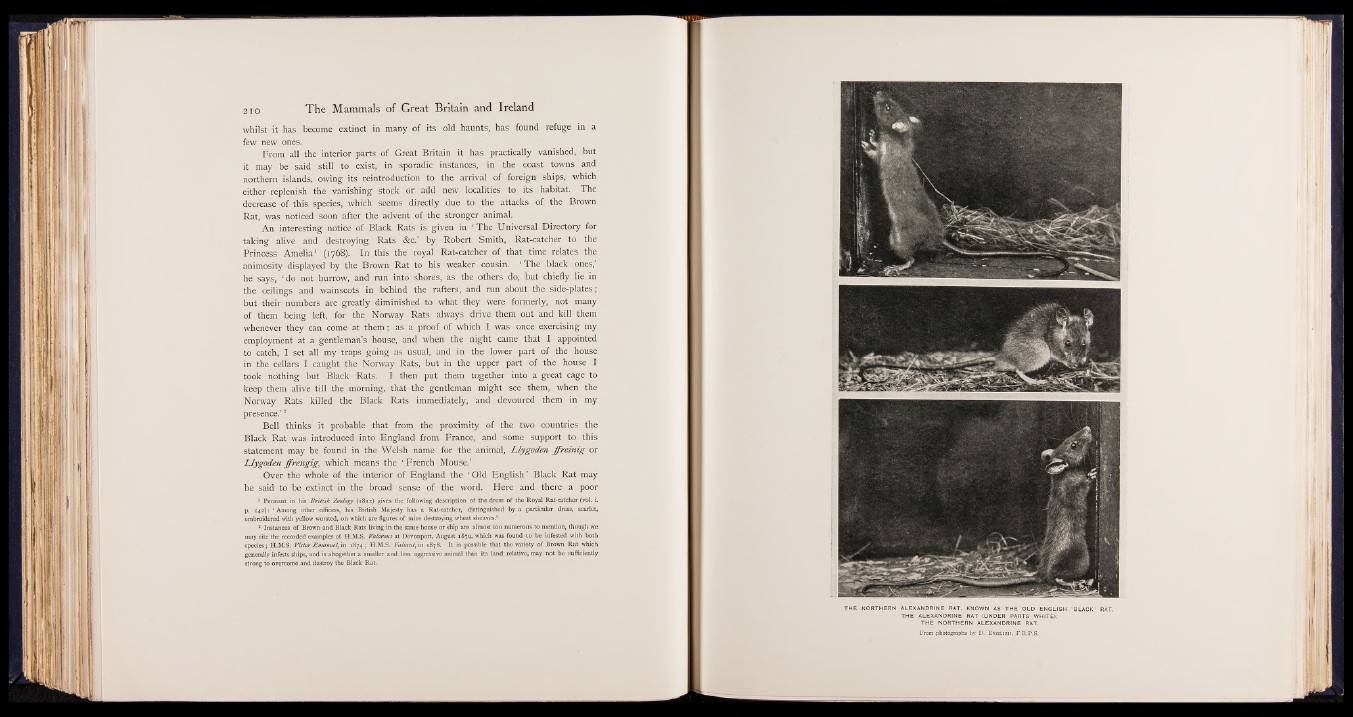
whilst it has become extinct in many of its old haunts, has found refuge in a
few new ones.
From all the interior parts of Great Britain it has practically vanished, but
it may be said still to exist, in sporadic instances, in the coast towns and
northern islands, owing its réintroduction to the arrival of foreign ships, which
either replenish the vanishing Stock or add new localities to its habitat. The
decrease of this species, which seems directly due to the attacks of the Brown
Rat, was noticed soon after the advent of the stronger animal.
An interesting notice of Black Rats is given in ‘ The Universal Directory for
taking alive and destroying Rats &c.’ by Robert Smith, Rat-catcher to the
Princess Amelia1 (1768). In this the royal Rat-catcher of that time relates the
animosity displayed by the Brown Rat to his weaker cousin. ‘ The black ones,’
he says, ‘ do not burrow, and run into shores, as the others do, but chiefly lie in
the ceilings and wainscots in behind the rafters, and run about the side-plates ;
but their numbers are greatly diminished to what they were formerly, not many
of them being left, for the Norway Rats always drive them out and kill them
whenever they can come at them ; as a proof of which I was once exercising my
employment at a gentleman’s house, and when the night came that I appointed
to catch, I set all my traps going as usual, and in the lower part of the house
in the cellars I caught the Norway Rats, but in the upper part of the house I
took nothing but Black Rats. I then put them together into a great cage to
keep them alive till the morning, that the gentleman might see them, when the
Norway Rats killed the Black Rats immediately, and devoured them in my
presence.’ 2
Bell thinks it probable that from the proximity of the two countries the
Black Rat was introduced into England from France, and some support to this
statement may be found in the Welsh name for the animal, Llygoden ffre in ig or
Llygoden ffren g ig , which means the ‘ French Mouse.’
Over the whole of the interior of England the ‘ Old English ’ Black Rat may
be said to be extinct in the broad sense of the word. Here and there a poor
1 Pennant in his British Zoology (18x2) gives the following description of the dress of the Royal Rat-catcher (vol. i.
p. 142): ‘ Among other officers, his British Majesty has a Rat-catcher, distinguished by a particular dress, scarlet,
embroidered with yellow worsted, on which are figures of mice destroying wheat sheaves.’
* Instances of Brown and Black Rats living in the same house or ship are almost too numerous to mention, though we
may cite the recorded examples of H.M.S. Valorous at Devonport, August 1879, which was found to be infested with both
species; H.M.S. Victor Emanuel, in 1874; H.M.S. Valiant, in 1878. It is possible that the variety of Brown Rat which
generally infests ships, and is altogether a smaller and less aggressive animal than its land relative, may not be sufficiently
strong to overcome and destroy the Black Rat
THE NORTHERN ALEXANDRINE RAT, KNOWN AS THE OLD ENGLISH ‘BLACK’ RAT. THiE ALEXANDRINE RAT (UNDER PARTS WHITE).
THE NORTHERN ALEXANDRINE RAT.
From photographs by D. English, F.R.P.Sl